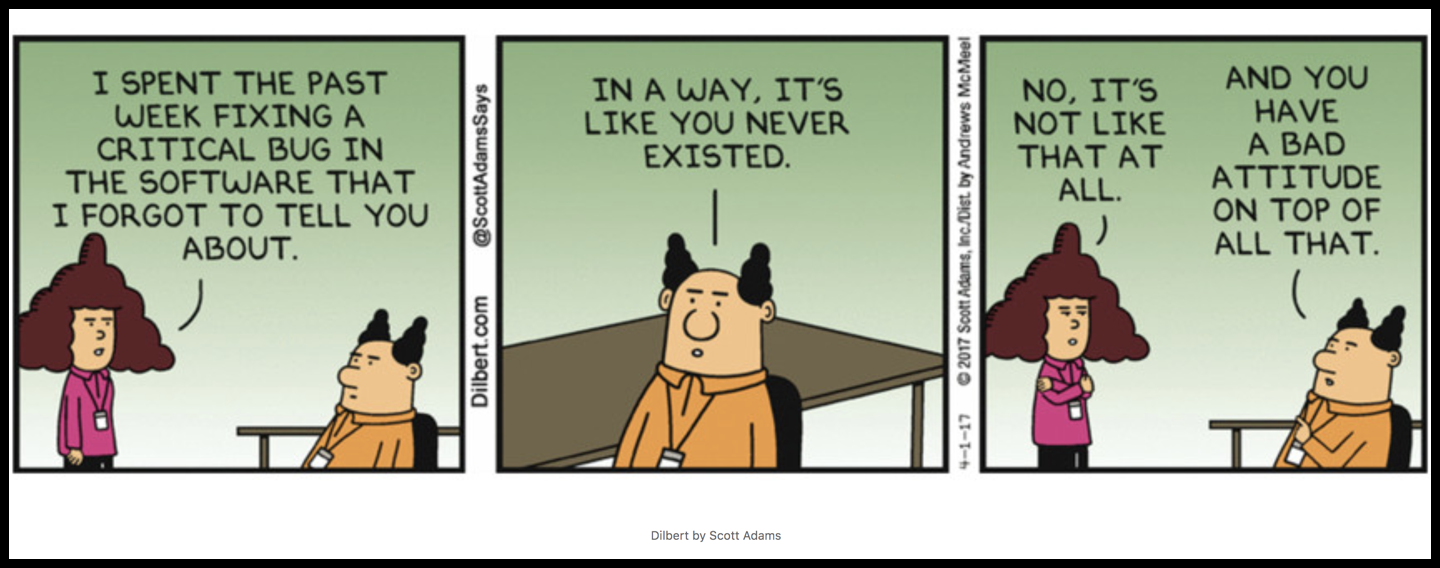One of my biggest clients is now threatening to leave because of a bug in my software, a bug that took a while -- apparently too long -- to fix. This deadly bug has killed a deal.
A [software] bug is an error, flaw, failure or fault in a computer program or system that causes it to produce an incorrect or unexpected result, or to behave in unintended ways.
The client emailed me in frustration. She was certain to state that I am not the problem and that, in fact, my service is impeccable. Then she suggested I go work for the competitor. She made it clear she got what she needed from them.
I tried to calmly reply with fact-based information in a friendly tone. I even have a smile on my face. However, in a reply, the client explodes into an angry tirade because the bug will not be fixed for a month. She even Cc'd two other buy-decision makers at her firm. Because of this bug and the time it took to fix, the client is going to cancel their subscription to the software when renewal time comes up. Because of no fault of my own, I have lost a major client.
How should I have handled this situation?
I did my best to reason with this client, but nothing I said helped the situation. It was important that I knew when to let go, as the client only gets angrier if you push. Since I was not the problem, I did not want to become another one.
Many of us have to deal with angry or unhappy clients as part of our roles, and it's never easy. Those of us in the law firm setting have to deal with angry internal clients on occasion. But if we know what to say and, more importantly, how to say it, we may be able to save the situation. In fact, we can even end up with a better relationship with our client than we had before.
I came across some great tips from Mind Tools online and thought you could benefit from them too.
#1: Adjust Your Mindset
Once you're aware that your client is unhappy then your first priority is to put yourself into a client-centric mindset.
This means that you set aside any feelings you might have that the situation isn't your fault, or that your client has made a mistake, or that he or she is giving you unfair criticism. In my case, the client was fair and acknowledged the issue was not with me. I was simply collateral damage.
All that matters is that you realize that your customer or client is upset, and that it's up to you to solve the problem if able. Adjust your mindset so that you're giving 100 percent of your focus to your client, and to the current situation.
#2: Listen Actively
The most important step in the whole of this process is listening actively to what your client or customer is saying – he wants to be heard, and to air his grievances.
Start the dialogue with a neutral statement, such as, "Let's go over what happened," or "Please tell me why you're upset." This subtly creates a partnership between you and your client and lets him know that you're ready to listen.
Resist the temptation to try to solve the situation right away, or to jump to conclusions about what happened. Instead, let your client tell you his story. As he's talking, don't plan out what you're going to say when he's done – this isn't active listening!
Also, don't allow anything to interrupt this conversation. Give your client ALL of your attention.
#3: Repeat Their Concerns
Once he's had time to explain why he's upset, repeat his concerns so you're sure that you're addressing the right issue. If you need to, ask questions to make sure that you've identified the problem correctly.
Use calm, objective wording. For example, "As I understand it, you are, quite rightly, upset because we didn't deliver the samples that we promised you last week."
Repeating the problem shows the customer you were listening, which can help lower his anger and stress levels. More than this, it helps you agree on the problem that needs to be solved.
#4: Be Empathic and Openly Apologize
Once you're sure that you understand your client's concerns, be empathetic. Show her you understand why she's upset. And, make sure that your body language also communicates this understanding and empathy. Every day, regardless of the situation, we should listen with empathy -- not judgment.
For example, you could say, "I understand why you're upset. I would be too. I'm very sorry the software has a bug that cannot be fixed sooner, especially since it's caused these problems."
#5: If Possible, Present a Solution
Now you need to present her with a solution. There are two ways to do this.
If you feel that you know what will make your client happy, tell her how you'd like to correct the situation.
If you're not sure you know what your client wants from you, or if they resist your proposed solution, then give her the power to resolve things. Ask her to identify what will make her happy.
For instance, you could say, "If my solution doesn't work for you, what do you propose? If it's in my power I'll get it done, and if it's not possible, we can work on another solution together."
#6: Take Action and Follow-up
Once you've both agreed on a solution, you need to take action immediately. Explain every step that you're going to take to fix the problem to your client. When in crisis control mode, never promise to do something and fail to do it, especially if that's what got you into this mess in the first place.
If she has contacted you by phone, make sure that she has your name and contact details. This gives her a feeling of control because she can get hold of you again if she needs to.
Once the situation has been resolved, follow up with your client over the next few days to make sure that she's happy with the resolution. Whenever you can, go above and beyond her expectations. For instance, you could send her a gift certificate, give her a great discount on her next purchase, or send her a hand-written apology.
#7: Use the Feedback
Your last step is to reduce the risk of the situation happening again.
If you haven't already done so, identify how the problem started in the first place. Was there a bottleneck that slowed shipment? Did a sales rep forget to confirm an order?
Find the root of the problem and make sure it's fixed immediately. Also, ensure that you're managing complaints and feedback effectively so that you can improve workflow and processes.
Further Tips
It's important to handle difficult customers professionally. Learning how to stay calm and cool under pressure can help you get through challenging situations with grace and professionalism.
If your client is especially angry, then talk slowly and calmly, and use a low tone of voice. This will subtly help lower the tension, and ensure that you don't escalate the situation by visibly getting stressed or upset yourself.
If your client has sent you a difficult email or they're angry with you over the phone, then offer to meet with him or her in person if you can to address the problem. This will not only diffuse anger (since it's harder for most people to get truly angry face to face) but it also shows that you genuinely want to address and fix the situation.
If you feel that your client is being unreasonable, you might start to get upset, especially if he or she is criticizing you, or your organization, unfairly. Take a deep breath so that you can stay calm in these situations. Realize you must fix what you can and let the rest go.
Occasionally a client or customer may become verbally abusive towards you or your team. Know in advance what you'll tolerate, and what you won't. Have boundaries. If things escalate, you may need to be assertive and stand up for yourself, or even walk away from the situation to give the client time to cool down.
People on your team might be the ones on the "front line" when it comes to dealing with difficult clients need to know how to engage correctly in emotional labor.
Work on improving conflict resolution skills. These skills can help you if you need to negotiate with your clients.
Key Take-Aways:
Dealing with difficult customers can be challenging. But if you handle the situation well, you may even be able to improve your relationship and create further opportunities.
Make sure that you listen actively to his problems or complaints, and resist the urge to interrupt or solve the problem right away. Be empathic and understanding, and make sure that your body language communicates this.
If you're not sure how to fix the situation, then ask your client what will make him happy. If it's in your power, then get it done as soon as possible. Follow up with your customer to make sure he was happy with how the situation was resolved.







